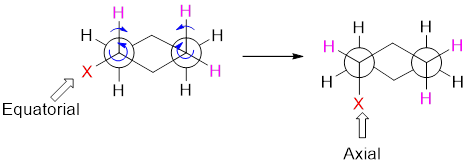
Concept explainers
(a)
Interpretation:
Adjacent equatorially oriented isopropyl ethyl groups experience severe steric interactions that lacking in the ethyl case; chair conformation of the former case that illustrate severe steric interactions; a Newman projection looking down one of the C-C bonds connecting the Cyclohexyl ring to an equatorial isopropyl group; a conformation with severe steric strain; all has to be examined and drawn.
Concept Introduction:
Conformations: Rotation about C-C single bonds allows a compound to adopt a variety of possible three-dimensional shapes.
Drawing Axial and Equatorial substituents:

Each carbon in cyclohexane can bear two substituents. One group is said to occupy an axial position, which is parallel to a vertical axis passing through the center of the ring. the other group is said to occupy an equatorial position, which is positioned approximately along the equator of the ring.
Conformations: Rotation about C-C single bonds allows a compound to adopt a variety of possible three-dimensional shapes.
Newman projections: The new conformations of compounds can be drawn and analyzed by Newman projections. A Newman projection visualizes different conformations of Carbon-carbon
The angle between two hydrogens of a Newman projection is called as dihedral angle or torsional angle. This dihedral angle changes as the C-C bond rotates. Two conformations with special attentions are staggered and eclipsed conformation. Staggered conformation is the lowest in energy and the eclipsed conformation is the highest in energy.
For example,

Anti-conformation: The conformation with a dihedral angle of

The two methyl groups achieve maximum separation from each other. In other, methyl groups are closer to each other; their electron clouds are repelling each other, causing an increase in energy. This unfavorable interaction is called gauche interaction.
Conversion of chair conformation into Newman projection:

Ring flipping between Newman projections:

Ring flipping is a conformational change that is accomplished only through a rotation of all C-C single bonds. On ring flipping between two chair conformation equatorial changes into axial and vice-versa.
(b)
Interpretation:
A Newman projection looking down one of the C-C bonds connecting the Cyclohexyl ring to an axial isopropyl group has to be drawn; the conformation is lower than the all-equatorial chair conformation in steric destabilization has to be illustrated.
Concept Introduction:
Nomenclature of organic compounds:
Conformations: Rotation about C-C single bonds allows a compound to adopt a variety of possible three-dimensional shapes.
Drawing Axial and Equatorial substituents:

Each carbon in cyclohexane can bear two substituents. One group is said to occupy an axial position, which is parallel to a vertical axis passing through the center of the ring. the other group is said to occupy an equatorial position, which is positioned approximately along the equator of the ring.
Conformations: Rotation about C-C single bonds allows a compound to adopt a variety of possible three-dimensional shapes.
Newman projections: The new conformations of compounds can be drawn and analyzed by Newman projections. A Newman projection visualizes different conformations of Carbon-carbon chemical bond from front to back with the front carbon represented as a black dot and the back represented as a circle.
The angle between two hydrogens of a Newman projection is called as dihedral angle or torsional angle. This dihedral angle changes as the C-C bond rotates. Two conformations with special attentions are staggered and eclipsed conformation. Staggered conformation is the lowest in energy and the eclipsed conformation is the highest in energy.
For example,

Anti-conformation: The conformation with a dihedral angle of

The two methyl groups achieve maximum separation from each other. In other, methyl groups are closer to each other; their electron clouds are repelling each other, causing an increase in energy. This unfavorable interaction is called gauche interaction.
Conversion of chair conformation into Newman projection:

Ring flipping between Newman projections:

Ring flipping is a conformational change that is accomplished only through a rotation of all C-C single bonds. On ring flipping between two chair conformation equatorial changes into axial and vice-versa.
Want to see the full answer?
Check out a sample textbook solution
Chapter 4 Solutions
Organic Chemistry
 ChemistryChemistryISBN:9781305957404Author:Steven S. Zumdahl, Susan A. Zumdahl, Donald J. DeCostePublisher:Cengage Learning
ChemistryChemistryISBN:9781305957404Author:Steven S. Zumdahl, Susan A. Zumdahl, Donald J. DeCostePublisher:Cengage Learning ChemistryChemistryISBN:9781259911156Author:Raymond Chang Dr., Jason Overby ProfessorPublisher:McGraw-Hill Education
ChemistryChemistryISBN:9781259911156Author:Raymond Chang Dr., Jason Overby ProfessorPublisher:McGraw-Hill Education Principles of Instrumental AnalysisChemistryISBN:9781305577213Author:Douglas A. Skoog, F. James Holler, Stanley R. CrouchPublisher:Cengage Learning
Principles of Instrumental AnalysisChemistryISBN:9781305577213Author:Douglas A. Skoog, F. James Holler, Stanley R. CrouchPublisher:Cengage Learning Organic ChemistryChemistryISBN:9780078021558Author:Janice Gorzynski Smith Dr.Publisher:McGraw-Hill Education
Organic ChemistryChemistryISBN:9780078021558Author:Janice Gorzynski Smith Dr.Publisher:McGraw-Hill Education Chemistry: Principles and ReactionsChemistryISBN:9781305079373Author:William L. Masterton, Cecile N. HurleyPublisher:Cengage Learning
Chemistry: Principles and ReactionsChemistryISBN:9781305079373Author:William L. Masterton, Cecile N. HurleyPublisher:Cengage Learning Elementary Principles of Chemical Processes, Bind...ChemistryISBN:9781118431221Author:Richard M. Felder, Ronald W. Rousseau, Lisa G. BullardPublisher:WILEY
Elementary Principles of Chemical Processes, Bind...ChemistryISBN:9781118431221Author:Richard M. Felder, Ronald W. Rousseau, Lisa G. BullardPublisher:WILEY





